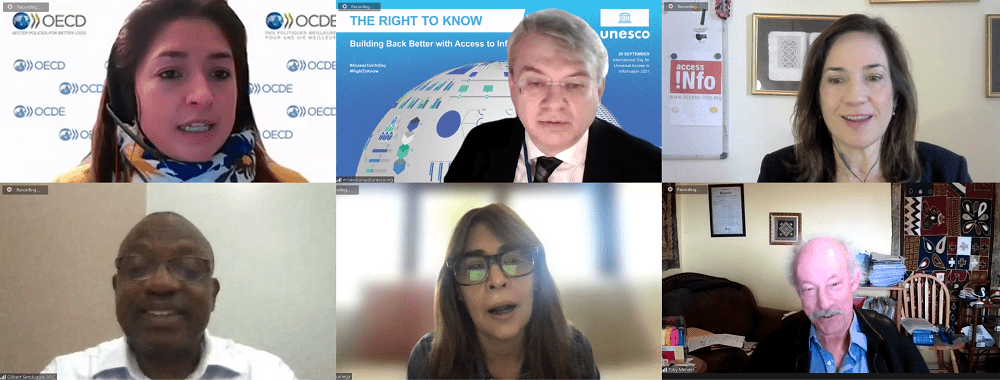14 December 2021 – The measurement of the right of access to information is still in its infancy, although there are now some important initiatives, including from UNESCO and the OECD to capture data from governments, whilst civil society projects are developing more in-depth tools to measure transparency in practice.
The current state of measurement of the right to information was discussed at an expert webinar that took place on 14 December 2021 as part of the Open Government Partnership summit. The full video of the webinar can be seen here: https://vimeo.com/657069498
An important conclusion of the debate was that the access to information community is clear on what needs to be measured and against which international standards.
UNESCO, in its role as custodian of Sustainable Development Goal indicator 16.10.2, has collected data from 102 countries, with governments reporting on five pillars: legal frameworks, oversight mechanisms, appeals mechanisms, record keeping and reporting, and analysis of the scope of exemptions. For more on the report see here.
The RTI Rating by Access Info Europe and the Centre for Law and Democracy, which has been running for over 10 years, remains the benchmark for access to information laws on paper, and the Freedom of Information Advocates Network, the Carter Centre and the Centre for Law and Democracy, have developed methodologies for evaluating everything from preparedness of public bodies to actual information disclosure.
Information Commissioners also play a key role in evaluating respect for the right of access to information, with the leading work being done by the Latin American region RTA, coordinated by Mexico’s National Access to Information Institute (INAI). UNESCO has also identified evidence that independent oversight bodies have a positive impact on the quality of implementation of access to information laws.
A major new initiative is the Global Data Barometer, being run in 109 countries, which looks not only at data availability, but also at the use of the data, will be launched in the first part of 2022. Access Info has collected data in 27 of the 109 countries. The GDB survey measures both the existence of legal frameworks requiring the collection and publication of data on the performance of the right of access to information, and the availability of the performance data in practice.
We can see however positive developments, with demand driving better data collection. The OECD has found that as countries get asked to report on transparency, they are likely to improve their measurement system. The speakers agreed that we need to demand better data collection by governments at the same time as funding civil society monitoring initiatives.
Challenges & Data Gaps
One of the biggest problems with measurement is that in many countries there is no obligation to collect data on implementation of access to information laws. In the 109 countries currently being evaluated by the Global Data Barometer, little over half, 61 countries, have some kind of legal obligation to collect implementation data. In practice, data is published in only 40 countries.
This tallies with an OECD finding where of 30 responses from governments, only 10 reported having existing national data collection systems. The OECD also identified that measurement approaches within countries are not consistent, that there is no evaluation of impact, and no feedback loops from requests to proactive publication.
Participants agreed that monitoring by government and civil society are both important, but that civil society often lacks resources to conduct monitoring, and a priority for 2022 should be to raise funds for this work.
Key Findings from Current Monitoring Exercises
- Institutional capacity is crucial in implementing the right to information and that external demand drives better responsiveness and there is evidence that it results in better organisation inside public authorities.
- Civil society can make a huge difference. Twenty years of monitoring by the Access to Information Programme (AIP) in Bulgaria has shown that awareness in and out of public authorities has risen significantly over time, helped by litigation in defence of the right (AIP wins 80% of legal challenges) and the resulting media coverage. All this leads to greater use and better implementation of the access to information law.
- Proactive disclosure tends to be of information that is easier to disclose. In Ukraine, for instance, monitoring using the FOIAnet tool has revealed that in spite of progress on proactive publication, much information for accountability and anti-corruption is still hard to obtain.
- Resources are key. We often find that good laws are undercut by failures of implementation, such as officials not having adequate resources or not being well trained (such as on how to apply exceptions). Resources in turn depend on political will, which is as decisive as the quality of the legal framework.
- Political will makes a difference. For instance, the African Freedom of Information Centre found that when comparing Namibia, Nigeria, and Zimbabwe, it was Namibia, without an ATI law, which scored better in responding to requests.
- The Open Government Partnership was noted as an excellent forum for fomenting political will. Publication of results on implementation should have an impact on political will.
- Without data we cannot evaluate progress on the Sustainable Development Goals, nor address inequalities. For example, in Africa around 60% of budgets go to procurement but, thanks to public procurement data being opened, it was revealed that only 1% goes to women-owned enterprises.
- We are not evaluating the ecosystem. Political context affects use of access to information laws: external factors such as trust in government, perceived levels of corruption, and threats to civic society, and all impact on whether people even request information and these are often overlooked when it comes to measurement.
- More information on users needed: Without forcing requesters or users of data to say who they are or why they want the information, more data is needed on who is benefitting from this right. Is it mainly CSOs and journalists? What is use by businesses? What about use by vulnerable groups, minorities, and those with disabilities? How can they be better assisted to exercise their right to information?
“What cannot be measured, cannot be improved” – Gilbert Sendugwa

